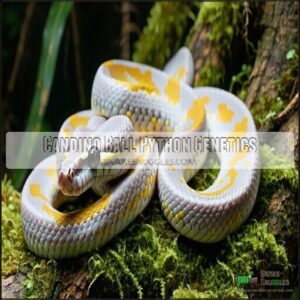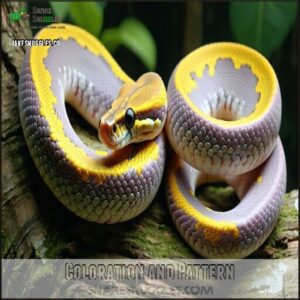This site is supported by our readers. We may earn a commission, at no cost to you, if you purchase through links.

It’s like nature brought a sunset to life! These pythons have a friendly temperament, making them a popular choice for both collectors and beginners.
Breeding one requires pairing a Candino with either an Albino, Candy, or another Candino, which can produce a range of visually stunning offspring.
Their care is similar to other ball pythons—think warm enclosures, consistent humidity, and a steady diet of appropriately sized prey. Want to know what makes them truly unique? Stay tuned!
Table Of Contents
- Key Takeaways
- Candino Ball Python Genetics
- Candino Ball Python Appearance
- Breeding Candino Ball Pythons
- Care and Husbandry Requirements
- Candino Ball Python Market and Availability
- Frequently Asked Questions (FAQs)
- How do you make a Candino ball python?
- What does a Candino ball python look like?
- How much does a Candino ball python cost?
- Is a Candino ball python a snake?
- Are Candino ball pythons rare?
- Do albino and candy pythons work together?
- How Often Do Candino Ball Pythons Need to Be Fed?
- What is the Temperament of a Candino Ball Python?
- What Type of Habitat is Best for a Candino Ball Python?
- How Can I Tell if My Candino Ball Python is Healthy?
- Conclusion
Key Takeaways
- You’ll love the Candino ball python for its vibrant colors that shift from yellow and white to soft lavenders as it matures.
- Breeding a Candino with either a Candy, Albino, or another Candino produces visually striking offspring, thanks to its double recessive genetics.
- Keeping one healthy requires a warm enclosure (88-92°F on the hot side, 78-80°F on the cool), 50-60% humidity, and regular feeding of appropriately sized rodents.
- These snakes are known for their calm temperament, making them a great choice for both beginners and snake collectors.
Candino Ball Python Genetics
You’ll find the Candino ball python’s genetics fascinating, as it’s a blend of two recessive traits: Candy and Albino.
A mesmerizing mix of Candy and Albino genes, the Candino ball python showcases nature’s artistry in vibrant, evolving hues.
This unique pairing creates snakes with vibrant colors and patterns that evolve throughout their lives, showcasing a fascinating blend of traits.
Recessive Genes
Recessive genes are like hidden gems in the sphere of snake genetics, only making an appearance when inherited from both parents.
For candino ball pythons, traits like Albino and Candy rely on recessive inheritance, staying masked as heterozygous traits unless perfectly matched.
Understanding gene expression and breeding outcomes is vital for successful pairings.
Without this knowledge, exploring ball python genetics feels like chasing shadows!
- Unearth the hidden potential in recessive genes.
- Discover the secrets of ball python genetics.
- Discover candino-inspired breeding magic!
Combination of Albino and Candy
The pairing of the Albino gene with the Candy gene creates the Candino ball python, a reptile truly unlike any other.
This Double Recessive genetic combination produces snakes with remarkable Visual Effects, including a Unique Palette that evolves dramatically throughout their lives.
Their Color Evolution begins with bright yellows and whites, gradually shifting to stunning lavender hues with reduced patterns that set them apart.
These snakes feel like living masterpieces, displaying intricate patterns that shift as they mature.
Albino ball pythons, known for their lack of melanin, exhibit unique colorations.
- Watch their warm yellows melt into soft lavender tones.
- Notice how light dances on their scales, revealing new colors.
- See rarity in action with this striking genetic mix.
- Own a bold piece of snake evolution.
Killer Blast Genetic Wizard
If you’re working on complex morph combinations like the candino ball python, the Killer Blast Genetic Wizard is a game-changer.
This handy genetic calculator predicts breeding outcomes based on parent morphs.
Curious about Blast compatibility or morph interactions? Simply plug in the genes, and watch potential genetic outcomes unfold.
It’s a stress-free way to refine breeding strategies while ensuring predictable visual outcomes, making it your personal morph-matchmaker!
Candino Ball Python Appearance
You’ll immediately notice the Candino Ball Python’s vibrant yellows, soft lavenders, and unique pink patterns that set it apart.
Vibrant yellows, soft lavenders, and striking pink patterns make the Candino Ball Python a living masterpiece of evolving artistry.
Its color palette evolves over time, making each stage of its life a fascinating display.
Coloration and Pattern
The candino ball python’s color evolution is mesmerizing. Initially, its body boasts albino-like yellow and white tones, but these shift to unique hues of lavender over time.
You’ll notice stunning visual effects, such as bold color contrasts and striking pattern reduction compared to standard ball pythons.
Here’s what sets their snake coloration apart:
- Color variations: Bright yellow with soft pink accents.
- Pattern variations: Reduced, with clean, smooth edges.
- Unique hues: Lavender tones as they mature.
- Color patterns: Pools of pink separated by solid yellow bands.
Size and Build
Your Candino ball python maintains an ideal, manageable size for keepers of all experience levels.
Hatchlings start small, growing steadily into an average adult length of 3-5 feet.
Males are usually slimmer, while females carry more body mass due to sexual dimorphism.
With their compact build, these snakes don’t need massive enclosures but still stretch out comfortably, embodying beauty and ease in care.
Visual Appearance
One of the most mesmerizing traits of a Candino ball python is its Color Evolution, turning it into a living masterpiece.
Starting with albino-like yellows and whites, their hues transform into soft lavenders, gradually resembling washed-out Ultramel tones.
This dynamic change in their color pigmentation is enhanced under proper lighting effects, highlighting their pattern intricacy.
Their smooth, darkened scales further boost their visual appeal, while bright red eyes add an extra pop to their color morphs.
Each Candino seems to tell its own artistic story, making this morph a stunning addition to any collection.
Breeding Candino Ball Pythons
When breeding Candino Ball Pythons, you’ll need to understand their unique genetic makeup, which combines the Candy and Albino genes.
Pairing the right snakes can produce stunning offspring, but precise pairings are essential for successful results.
Breeding History and Rarity
You’ve likely heard of Candino ball pythons being genetic marvels, but their breeding history is just as fascinating.
This rare designer morph originated from painstaking efforts, involving significant breeding challenges and carefully curated founding bloodlines.
Candino’s rarity stems from its complex genetic makeup and limited heritage tracking by breeders.
Here’s a quick glimpse into their story:
- First visual candies appeared in 2008, proving Candy’s recessive trait.
- Early 2000s saw initial pricing soar above $5000.
- Breeding cycles were slow, restricting availability.
- Today, Candinos hold a prized genetic legacy in reptile collections worldwide, with a complex genetic makeup and a history of being a rare designer morph.
Genetic Combinations and Outcomes
When breeding, understanding allele interactions and genetic probability is a must.
Pair a Candy with an Albino, and you’ll produce 100% Candino offspring – a fascinating twist on ball python genetics.
Two Candinos together create 25% Albinos, 25% Candies, and 50% Candinos.
Punnett squares in breeding can help predict these genetic ratios.
Morph inheritance shapes these outcomes, as genotype directly influences the vibrant phenotype of every baby snake.
Breeding With Other Morphs
Pairing Candinos with other ball python morphs reveals endless possibilities for stunning visual outcomes.
Morph compatibility is key—try breeding with Pastel for brighter hues or Black Pastel for dramatic pattern interactions.
Enchi Candinos bring unique subtlety to their recessive traits.
Patience pays off in tracking ball python genetics, as each pairing enriches genetic diversity with breathtaking patterns.
Document genetic combinations painstakingly to perfect your results, and remember that morph compatibility is crucial for achieving the desired visual outcomes, which can lead to stunning visual effects.
Care and Husbandry Requirements
You’ll need to provide your Candino Ball Python with a clean, well-maintained enclosure that mimics its natural habitat.
Maintain proper temperature, humidity, and feeding schedules to keep it healthy and stress-free.
Environmental and Dietary Needs
Keeping your Candino healthy starts with the right setup.
Stick to a temperature gradient: 88-92°F on the hot side and 78-80°F for cooling off.
Humidity levels should stay around 50-60%, bumping up during shedding.
For bedding, go with a substrate choice like cypress mulch or coconut husk—it’s comfy and holds moisture well.
Feed appropriately-sized rodents every 7-10 days, depending on your python’s size.
Always keep fresh water available, in a bowl big enough for occasional soaking.
Maintaining proper humidity helps prevent common shedding problems.
It’s simple but effective husbandry!
Health Considerations and Precautions
Your Candino ball python’s health depends on good care and keen observation.
Watch out for respiratory issues like wheezing or bubbling nostrils, and always practice mite prevention by inspecting for tiny black dots.
Feeding refusals may signal stress or improper conditions, so maintain enclosure hygiene and stick to proper temperatures (88-92°F hot spot).
Keep humidity at 50-60% to prevent skin problems, and consider using specialized products to combat ball python mites.
Pair clean water and a solid diet with stress reduction for snake health and peak performance – they’ll thank you silently!
Ethical Considerations and Responsibility
Owning a Candino Ball Python means embracing ethical considerations and ensuring proper animal welfare.
Instead of just seeing them as stunning pets, aim to be a responsible owner. Follow these five steps:
- Purchase from reputable breeders who value snake welfare over profit.
- Prioritize genetic diversity by researching morph-specific implications.
- Never release captive reptiles into the wild—it harms ecosystems.
- Support conservation efforts to protect wild ball python populations.
- Spread awareness about responsible ownership and reptile ethics.
Caring for these snakes goes beyond their beauty—it’s about informed purchasing and dedication.
Candino Ball Python Market and Availability
You’ll find Candino Ball Pythons available through select breeders, reptile expos, and online marketplaces, with prices ranging from $250 to over $1,000 depending on genetics and quality.
Females often cost more than males, and reputable sellers prioritize snake health and ethical breeding practices.
Pricing and Availability
If you’ve set up everything for your new snake, it’s time to explore Candino ball python prices. Pricing ranges from $65 to $1,500, influenced by morph demand, genetic traits, and breeder reputation.
Market trends show high variability depending on breeder availability and location. Here’s a quick overview:
| Price Range | Genetic Influence | Payment Options |
|---|---|---|
| $65 – $200 | Basic morphs, limited demand | Full payment |
| $200 – $500 | Mid-tier traits, moderate demand | Flexible plans |
| $500 – $1,500+ | High-demand, rare genetic lineage | Payment installments |
Research morph prices for the best deal, considering factors like breeder reputation and genetic traits to make an informed decision.
Reputable Breeders and Sellers
Finding reputable ball python breeders guarantees you get a healthy candino ball python while supporting breeder ethics.
Look for sellers who provide health guarantees, lineage tracking, and transparency about pricing factors and genetics.
Check out trusted breeder listings like Wilbanks, Inc. or ReptileKreations, known for their expertise and customer support.
Ask questions about care, health, and payment options—good breeders are helpful and responsive.
Captive bred snakes are less likely to carry parasites and are generally healthier.
Online communities also share reviews to guide you toward ethical, knowledgeable sellers who prioritize snake welfare and support good breeding practices.
Frequently Asked Questions (FAQs)
How do you make a Candino ball python?
You create a Candino ball python by breeding a Candy and an Albino ball python.
Both genes are recessive, so offspring inherit one allele from each parent, producing the vibrant, unique Candino look.
What does a Candino ball python look like?
Imagine a living sunset; a Candino ball python glows with vibrant yellows, oranges, and purples.
Its patterns evolve from albino-like tones to lavender hues, highlighted by red eyes and intricate, contrasting designs, showcasing a living sunset.
How much does a Candino ball python cost?
You’ll find Candino ball pythons priced between $200 and $1,500, depending on their genetics, age, and breeder.
Females tend to cost more, and unique traits or high-quality lineage can bump up the price, with genetics being a key factor.
Is a Candino ball python a snake?
Of course, a Candino ball python is a snake!
It’s a stunning, genetically unique ball python morph with vibrant colors and evolving patterns.
Its charm lies in its mix of beauty, genetics, and rarity.
Are Candino ball pythons rare?
Candino ball pythons aren’t extremely rare, but they’re certainly not common.
Their unique genetics and vibrant colors make them highly sought after, though you’ll need to find reputable breeders to guarantee quality and care, which is crucial for these unique animals.
Do albino and candy pythons work together?
Albino and Candy ball pythons pair perfectly, creating visually stunning Candino offspring.
Both genes are recessive, so breeding them requires careful planning.
The result is vibrant yellow and lavender-hued snakes that showcase the best of both traits.
How Often Do Candino Ball Pythons Need to Be Fed?
You might worry about overfeeding, but adult Candino ball pythons thrive on one appropriately-sized meal every 7-14 days.
Juveniles eat more often—about once every 5-7 days.
Keep portions manageable to avoid obesity.
What is the Temperament of a Candino Ball Python?
You’ll find Candino Ball Pythons calm and easygoing.
They rarely show aggression and adapt well to handling, though patience helps them feel secure.
Their docile nature makes them great pets, even for first-time snake owners.
What Type of Habitat is Best for a Candino Ball Python?
Set up a cozy enclosure with a warm side at 88-92°F, a cool side at 78-80°F, and 50-60% humidity.
Add hiding spots, proper lighting, and a soft substrate for comfort.
How Can I Tell if My Candino Ball Python is Healthy?
Your Candino ball python’s health shows in its appetite, smooth scales, clear eyes, and alert behavior.
It should shed easily in full pieces.
Watch for any signs of lethargy, wheezing, or unusual skin coloration.
Conclusion
Like a masterpiece painted by nature, the Candino ball python is a stunning blend of genetics and artistry.
Its unique mix of Albino and Candy traits creates visuals as enchanting as a sunset, paired with an easygoing temperament that’s perfect for enthusiasts and newcomers alike.
Proper care—like maintaining warmth, humidity, and nutrition—ensures these snakes thrive.
Whether you’re drawn by its beauty or genetics, the Candino ball python truly stands out as a remarkable and rewarding pet.















